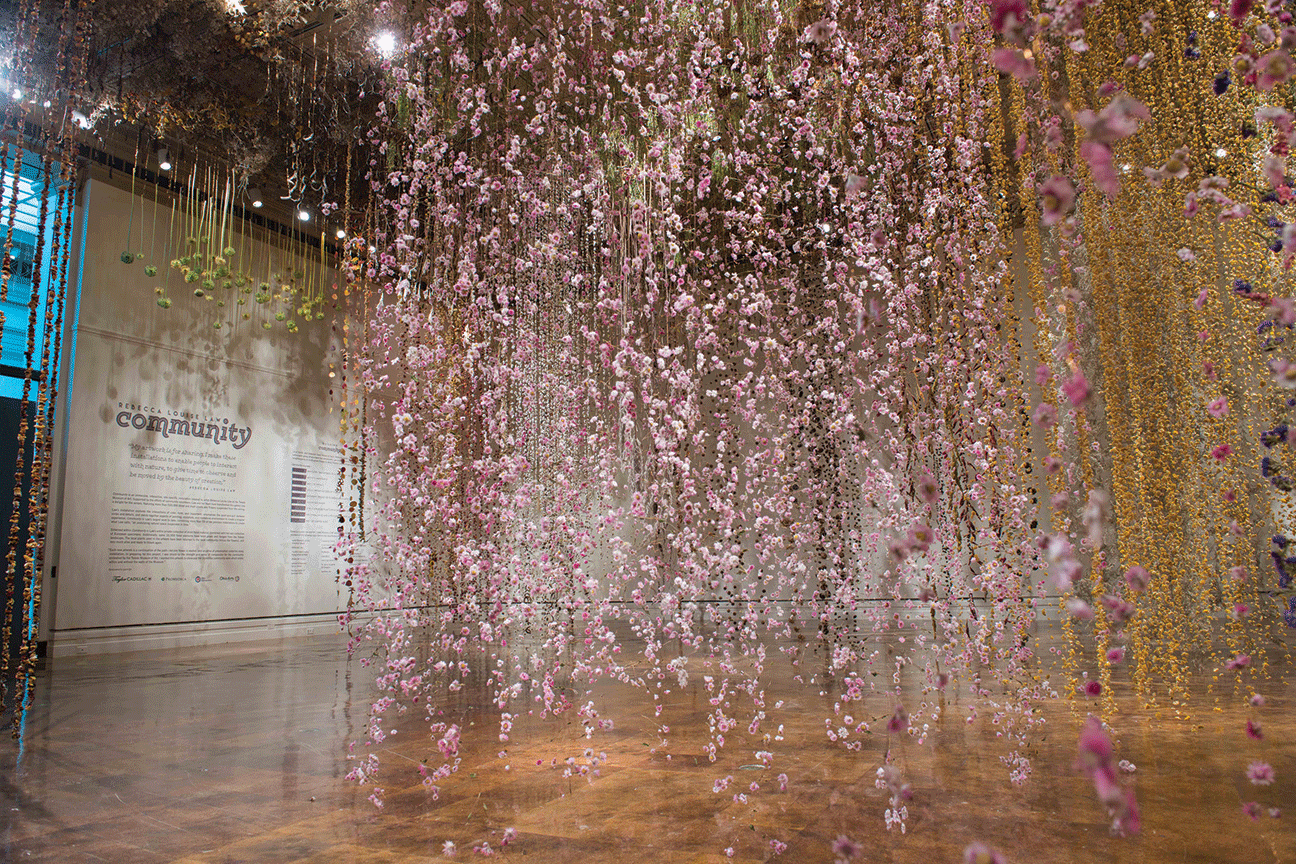« Reviews
Rebecca Louise Law: Community
Toledo Museum of Art - Toledo, Ohio
By Tim Hadfield
The Toledo Museum of Art is folded away with those other eminent museums in the formerly storied cities of Detroit, Cleveland, Erie and Buffalo–a string of gems thrown south around the neck of Lake Erie.
Advance publicity for British artist Rebecca Louise Law’s installation in the large, rectangular Canaday Gallery, gave the impression that we would encounter a space filled with freshly–or at least recently picked–flowers, foraged through a coordinated initiative with a local community that spent 1,800 hours collecting specimens from the North-West Ohio region. The truth was close, but an interesting twist on this preconception and one only has to step into “Community” for a few seconds, to get it. An all-enveloping sensory tour-de-force fills the entire gallery, festooned from ceiling to floor and wall-to-wall, with strings of dried and still-drying flowers, as well as lesser numbers of seed heads, grasses and fungi.
The flowers do not resemble those picked, succulent and colorful, from an English garden more familiar to the artist. Nor do they hold specific meaning like the bunched expressions of congratulation, love, and condolence we gift and receive. Instead, over half a million individual botanical fragments resonate less of cultivation and domestic interior, than with the scale and elemental presence of this country’s vast open prairies and plains. Their analogous fall-like color palette, overwhelming numbers, and the beauty of their individual forms, is subsumed into giant strings that hang in misty clouds, pour down in soft waterfalls and blossom in curtains, each appearing to hover in thin air amongst shafts of dappled light–beckoning us to enter the translucent, shimmering forest.
As one does, paths emerge between the groupings of like vegetation, springing from a garlanded canopy above, their strings reminiscent of childhood ‘daisy chains’. The individual floral and plant forms are held together with fine copper wire, its tensile strength enabling the artist to set their stems at any angle she wishes, creating differing rhythms and densities for each species. The strands appear to twist and turn, when in fact they are relatively stable–an illusion amplified by our own movement through the vegetal moiré patterns. This complex layering makes us acutely aware of our literal ‘depth of field’, in which every visual element is seen loosely woven against a multiplicity of others, teasing our focus back and forth. This was perhaps the most subtle and interesting aspect of the installation–I imagine particularly so for a generation brought up on flat screen monitors and cell phone screens–Generation 2D?
Law references the color field paintings of Mark Rothko as an influence and her aim for the installation, “to feel as if I’m walking into a painting” reflects this influence and her training as a painter, as it also nails the ‘big idea’ of the installation as an immersive experience. Though she later notes; “I soon began to realize that color wasn’t what mattered as much; it’s about nature and preservation, processes of life and decay,” addressing the absence of lush, saturated color and the deeply scented blooms of freshly cut flowers, that were no doubt her original inspiration.
This evolution is no surprise when working with a material that is dying from the moment it is picked, and which of us hasn’t left a vase of flowers to die, enjoying their unpredictable transformation into more permanent dried forms? Yet arrays of attractive color juxtapositions still do remain in “Community” to pique the eye, blended with the more subdued, though still exotic scents of grassy, spicy notes.
Law also follows an illustrious lineage of British landscape artists, Richard Long, David Nash and Andy Goldsworthy, whose work she would know intimately. All have worked with many of the same natural materials and landscape Law does, though all three are far more concerned with the connection between those materials and the specificity of site. Law’s priority is her connection between the materials and the communities where her exhibitions are located. Their volunteer contribution of collecting, stringing and displaying the vegetation, expresses the ‘ownership’ the artist views as central to the ethos of this work.
It has to be said though, that the harvest of the local community is indistinguishable from that of the many other communities Law has worked with, also featured in the exhibit, apparently from 51 previous installations as far afield as Athens, San Francisco, New York and London. At some point, questions may arise about ‘ownership’ of an installation created with thousands of hours of volunteer work, coupled with the risk of repetition and overexposure, like an old rock band on tour.
Nevertheless, it’s hard to argue with the overwhelming beauty of this installation, visitors are enthralled and children in particular, spellbound. After all, do we need to know which community is represented, and where in the installation? In the present climate of divisive geopolitics, we strive for a society that values diversity and a sense of community that is international. Here an artist and a common purpose has united people separated by geography, nationality and race, they come together to build a new inclusive and global “Community” with a work of art that transcends those divisions. Timely and timeless.
(June 16, 2018 - January 13, 2019)
Tim Hadfield is a British artist, educator and curator. He is currently a professor of media arts at Robert Morris University in Pittsburgh.
Filed Under: Reviews





































Leave a Reply
You must be logged in to post a comment.